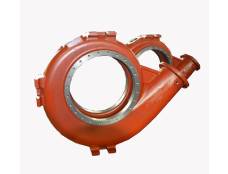+86 311 85258258
+86 311 85258258
Nov. 27, 2020
The Influence Of The Five Elements Of Ductile Iron On Castings
The chemical composition of ductile iron mainly includes five common elements: carbon, silicon, manganese, sulfur, and phosphorus. For some castings with special requirements for structure and performance, a small amount of alloying elements are also included. Different from ordinary gray cast iron, in order to ensure graphite spheroidization, nodular cast iron must contain trace residual spheroidizing elements.
1.The selection principle of carbon and carbon equivalent: Carbon is the basic element of ductile iron, and high carbon is helpful for graphitization. Because the influence of graphite on mechanical properties has been minimized after the graphite is spherical, the carbon content of ductile iron is generally higher, between 3.5% and 3.9%, and the carbon equivalent is between 4.1% and 4.7%. The upper limit is taken when the casting wall is thin, the residual amount of spheroidizing elements is large or the incubation is insufficient; otherwise, the lower limit is taken. Choosing the carbon equivalent near the eutectic point can not only improve the fluidity of the molten iron but for ductile iron, the increase in the carbon equivalent will also increase the self-feeding ability of the molten iron due to the increase in the graphitization expansion of the cast iron during solidification. However, too high carbon content can cause graphite to float. Therefore, the upper limit of the carbon equivalent in ductile iron is based on the principle that no graphite floats occur.
2.The selection principle of silicon: Silicon is a strong graphitizing element. In spheroidal graphite cast iron, silicon not only can effectively reduce the tendency of white mouth and increase the amount of ferrite but also has the function of refining the eutectic group and improving the roundness of graphite spheres. However, silicon increases the ductile-brittle transition temperature of cast iron and reduces the impact of toughness. Therefore, the content of silicon should not be too high, especially when the content of manganese and phosphorus in cast iron is high, the content of silicon must be strictly controlled. The final silicon content in ductile iron is generally 1.4-3.0%. After selecting the carbon equivalent, generally, adopt the principle of high-carbon and low-silicon strengthening inoculation. The lower limit of silicon is based on the principle that free cementite does not appear.
3.Manganese selection principle: Since the sulfur content in ductile iron is already very low, there is no need for excessive manganese to neutralize sulfur. The function of manganese in ductile iron is mainly to increase the stability of pearlite and promote the formation of (Fe, Mn) 3C. These carbides are segregated in grain boundaries and have a great influence on the toughness of ductile iron. Manganese will also increase the ductile-brittle transition temperature of ferritic ductile iron. For every 0.1% increase in manganese content, the brittle transition temperature will increase by 10-12°C. Therefore, the manganese content in ductile iron is generally as low as possible. Even in pearlitic ductile iron, the manganese content should not exceed 0.4 to 0.6%. Only medium manganese ductile iron and bainite ductile iron for the purpose of improving wear resistance are exceptions.
4.The selection principle of phosphorus: Phosphorus is a harmful element. Its solubility in cast iron is extremely low. When its content is less than 0.05%, it is solid-dissolved in the matrix and has almost no effect on the mechanical properties. When the content is greater than 0.05%, phosphorus is easily segregated at the boundary of the eutectic group, forming binary, ternary, or composite phosphorus eutectic, reducing the toughness of cast iron. Phosphorus increases the ductile-brittle transition temperature of cast iron. For every 0.01% increase in phosphorus content, the ductile-brittle transition temperature increases by 4 to 4.5°C. Therefore, the lower the content of phosphorus in ductile iron, the better, and should be less than 0.08% in general. For more important castings, the phosphorus content should be less than 0.05%.
5. Sulfur selection principle: Sulfur is a kind of despheroidizing element. It has a strong affinity with magnesium, rare earth, and other spheroidizing elements. The presence of sulfur will consume a large amount of spheroidizing elements in molten iron to form magnesium and rare earth. The sulfide in the product can cause casting defects such as slag inclusion and pores. The sulfur content in ductile iron is generally required to be less than 0.06%.
6. The selection principle of spheroidizing elements: The spheroidizing elements currently used in the industry are mainly magnesium and rare earth. Magnesium and rare earth elements can neutralize the despheroidizing elements such as sulfur and make graphite grow in a spherical shape. The residual amount of magnesium and rare earth should be determined according to the content of despheroidizing elements such as sulfur in the molten iron. On the premise of ensuring qualified spheroidization, the residual amount of magnesium and rare earth should be as low as possible. Too high residual amounts of magnesium and rare piles of the earth will increase the whitish tendency of molten iron and affect the mechanical properties of castings due to their segregation on the grain boundaries.

We're ductile iron suppliers. If you are interested in our products, please feel free to contact us.
PREVIOUS: What Is Ductile Iron?